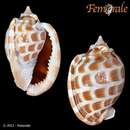en
names in breadcrumbs


Die Karierte Helmschnecke (Phalium areola) ist eine Schnecke aus der Familie der Helmschnecken (Gattung Phalium), die im Indopazifik verbreitet ist und sich von Seeigeln ernährt.
Das mäßig große Schneckenhaus von Phalium areola hat ein spitzes Gewinde und einen Körperumgang mit einer stumpfen, glatten, gewinkelten Schulter. Jeder Umgang ist mit einer wohl entwickelten Varix besetzt. Die Naht ist etwas eingedrückt. Die Gehäusemündung ist mäßig breit, der Siphonalkanal kurz und nach oben gebogen. Die äußere Lippe der Gehäusemündung ist an ihrem inneren Rand stark gezähnt. Die Oberfläche des Hauses ist cremig weiß mit 4 bis 5 spiraligen Reihen großer quadratischer dunkelbrauner oder tief orangener Flecken. Das Haus erreicht bei ausgewachsenen Schnecken rund 9 cm, zuweilen bis zu 12 cm Länge.[1]
Phalium areola ist im Indopazifik von der süd- und ostafrikanischen über Mauritius, Mauritius, Réunion, Seychellen, Sri Lanka, Indien bis nach Melanesien und Samoa, nördlich nach Japan und südlich bis nach Neusüdwales und Neukaledonien verbreitet. Die Schnecke lebt auf sandig-schlammigem Untergrund in der Gezeitenzone und bis in Tiefen von 7 m.
Wie andere Helmschnecken ist Phalium areola getrenntgeschlechtlich. Das Männchen begattet das Weibchen mit seinem Penis. Das Weibchen legt die Eier in Gelegen zahlreicher horniger Eikapseln ab, die jeweils mehrere hundert Eier enthalten. Ein Großteil der Eier entwickelt sich zu Embryonen. Die pelagische Phase der Veliger-Larven vom Schlupf aus der Eikapsel bis zur Metamorphose zur fertigen Schnecke dauert etwa zwei Monate.
Phalium areola ernährt sich von Seeigeln, die mit dem giftigen Speichel aus der Schnauze der Schnecke gelähmt werden.[2]
Die Karierte Helmschnecke (Phalium areola) ist eine Schnecke aus der Familie der Helmschnecken (Gattung Phalium), die im Indopazifik verbreitet ist und sich von Seeigeln ernährt.
Phalium areola, common name the checkerboard bonnet, is a species of sea snail, a marine gastropod mollusc in the subfamily Cassinae, within the family Cassidae the helmet and bonnet shells. It is also known as the checkerboard bonnet shell.[1]

This species occurs in the Indian Ocean along Madagascar, the Mascarene Basin, Tanzania and off the southern African coast from KwaZulu-Natal and Mozambique.[2] It can also be found in Melanesia and along Samoa.[3][4]
The size of an adult shell varies between 35 mm and 130 mm.[3] These medium-sized shells are oval and acuminate, with a rather narrow mouth, the outer lip folded back and internally denticulate. Shoulder are not angulate nor plicate and the anterior prickles on outer lip obsolete. The surface of the shell is white with five series of large squarish red-brown spots (hence the common name). Later whorls show spiral striae anteriorly on whorls and above shoulders.[5][6]
Phalium areola, common name the checkerboard bonnet, is a species of sea snail, a marine gastropod mollusc in the subfamily Cassinae, within the family Cassidae the helmet and bonnet shells. It is also known as the checkerboard bonnet shell.
 An apertural view of a shell of Phalium areola
An apertural view of a shell of Phalium areola
Phalium areola est une espèce de mollusque gastéropode marin appartenant à la famille des Cassidae. C'est un coquillage commun.
Le phalium areola a un fond de couleur rose à noisette clair avec quatre séries de taches "carrées" châtaigne.
Phalium areola est une espèce de mollusque gastéropode marin appartenant à la famille des Cassidae. C'est un coquillage commun.
Phalium areola is een slakkensoort uit de familie van de Cassidae.[1] De wetenschappelijke naam van de soort is voor het eerst geldig gepubliceerd in 1758 door Linnaeus.
Bronnen, noten en/of referentiesPhalium areola là một loài ốc biển lớn, là động vật thân mềm chân bụng sống ở biển trong họ Cassidae, họ ốc kim khôi.[1]
Phalium areola là một loài ốc biển lớn, là động vật thân mềm chân bụng sống ở biển trong họ Cassidae, họ ốc kim khôi.
棋盘鬘螺(学名:Phalium areola),是异足目唐冠螺科鬘螺属的一种。主要分布于马来西亚、印度尼西亚、中国大陆、台湾,常栖息在潮间带至水深数十米。[1]